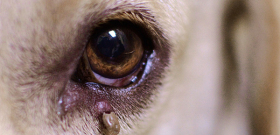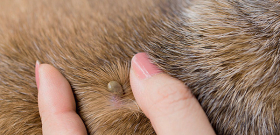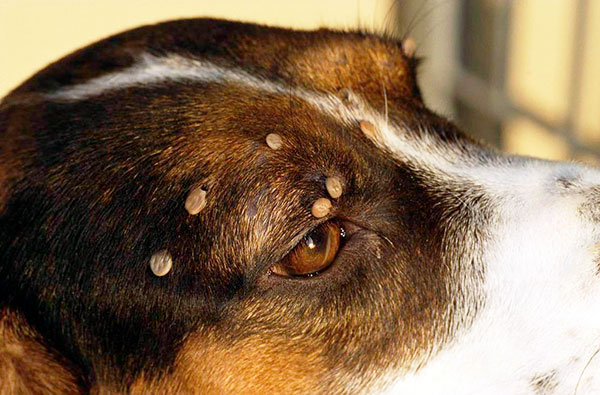
The situation when a tick has bitten a dog is ordinary, and even ordinary for many dog breeders. For example, hunters who spend days with dogs in wild and semi-wild areas remove parasites from their pets on almost every walk.
However, tick bites can be deadly to dogs, even though they are generally harmless. With some (albeit very small) probability, a bite can infect a pet with diseases that, without proper therapy, can be fatal, and the treatment of some of these diseases at home is ineffective.
Moreover, sometimes individual tick-borne infections develop in the dog's body according to a hyperacute scenario. In this case, the dog does not even have time to show symptoms of the disease: it simply dies suddenly, and only an autopsy and post-mortem bacteriological analysis of tissues show the presence of pathogens that could enter the animal’s body only with a tick bite.
All this means that if a tick has bitten a dog, you do not need to panic, but you should immediately take relatively simple, but urgent measures that will minimize the likelihood of infection specifically with this bite.And if the infection does occur, then in time to identify the developing disease and begin its treatment when it will almost certainly save the pet.
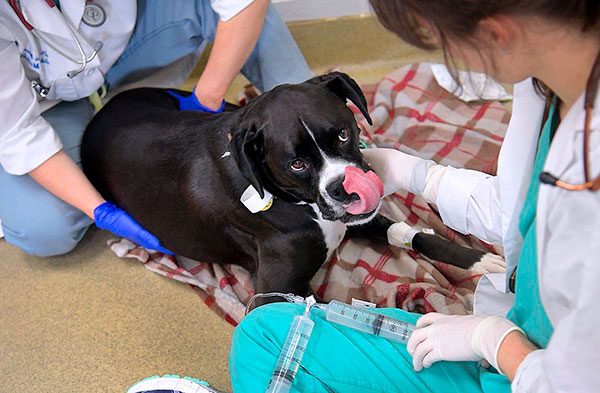
After a tick bite, it is important to notice the symptoms of a developing disease in time and start treating your dog.
Let's take a look at the sequence of these actions step by step, but before that we will find out what to be wary of with such bites. After all, only knowing the danger and the enemy "in the face", you can take effective measures to protect against them.
How dangerous are tick bites for dogs?
By themselves, both ticks and their bites are not dangerous for a dog - the animal tolerates them in much the same way as a person tolerates mosquito bites. Perhaps even easier: the tick bites completely painlessly, without causing any itching or redness. This ensures complete invisibility of their bites, and with it - and maximum safety for the parasites themselves.

The animal, as a rule, does not feel the bite of the tick, which is what the parasite uses.
The most dangerous for dogs are infections, the pathogens of which spend one or another part of the life cycle in the body of the tick. When bitten, these pathogens can enter the tissues and blood of the dog with the saliva of the parasite, and if the pet's immunity does not eliminate them, they will begin to multiply here. In this case, the disease will develop.
The most dangerous of these diseases are:
- Piroplasmosis (aka babesiosis), caused by blood parasites - babesia. It is considered the most common and most dangerous tick disease for dogs., in more than half of the diagnosed cases of tick-borne infections in dogs, it is piroplasmosis that develops.Its lethality without specific treatment in young dogs (up to 1 year old) exceeds 72% according to the average data for Western Europe;
- Lyme disease is caused by Borrelia. The disease is equally dangerous for both dogs and humans, but in dogs it is more difficult to detect it in a timely manner due to the fact that its symptoms are hardly noticeable on the pet's skin. Its lethality is lower than that of piroplasmosis, it often becomes chronic with damage to the joints;
- Ehrlichiosis is a disease etiologically close to endemic typhus in humans, as it is caused by rickettsiae. Often develops in parallel with piroplasmosis, but in itself rarely leads to death;
- Spotted fever, occurring with numerous hemorrhages, a significant increase in body temperature and often with conjunctivitis. Left untreated, it often results in the death of the dog.
Another notable tick-borne infection, hepatozoonosis, is not transmitted by a tick bite, but by a dog accidentally eating it.

Hepatozoonosis can develop when a tick is swallowed by a dog.
It is interesting
The most dangerous tick-borne infection for humans - tick-borne encephalitis - is not transmitted to dogs. Therefore, if a pet is bitten by an encephalitis tick, there is no chance of a dog being infected with tick-borne encephalitis.
A somewhat rarer disease in dogs is tick paralysis. It develops not due to infection of the pet, but due to the ingestion of a toxin into its body, which, when fed on an animal, is produced by adult females of some types of ticks.Moreover, this condition does not require any specific treatment - it is enough to remove the tick from the dog so that it stops releasing the toxin into the blood, and the symptoms of the disease end relatively quickly (with rare exceptions). However, if the parasite is not removed, the dog may die from tick paralysis.
And even more rarely, tick bites cause an allergic reaction in dogs, sometimes very violent, in isolated cases - with symptoms of anaphylaxis and death. However, among the other consequences of ixodid bites in dogs, allergy can be considered the least likely outcome.
Simply put, a dog cannot die from the very bite of a tick and blood sucking. But if an infection occurs during this bite, or a tick secretes a toxin into the wound when sucking blood, this can be a threat to her life and sometimes emergency measures must be taken to save the pet.
Piroplasmosis as the main threat to a pet
Pyroplasmosis is considered the greatest danger of tick bites in dogs for three reasons:
- The disease is widespread and even a dog that has been bitten by a tick in the city can get sick with it;
- Piroplasmosis is characterized by high mortality, and it is higher in puppies and young dogs;
- The disease requires special treatment with the use of antiparasitic drugs prescribed by a doctor. It can be carried out at home, but only as directed by a veterinarian. Simple symptomatic treatment is ineffective.
Piroplasmosis is a blood disease in which babesia (parasites from the protist group) infect red blood cells and lead to their destruction.As a result, the transport function of the blood is disrupted, which leads to a general weakening of the animal's body - the dog becomes less mobile, quickly begins to suffocate even with relatively small physical exertion for it (the muscles do not have time to receive the right amount of oxygen, which is carried by erythrocytes), its appetite worsens .

Blood smear affected by piroplasmosis.
With the destruction of the affected erythrocytes, and with it the death of part of the piroplasms, strong toxins are released into the dog's blood, which cause an increase in the body temperature of the animal, disruption of the gastrointestinal tract and various symptoms from the nervous system.
As a result, the general condition of the animal is rapidly deteriorating and without emergency intensive treatment, the dog usually dies on the 4-6th day after the first signs of the disease appear.
For the treatment of piroplasmosis, special antiparasitic drugs are used that are effective against protozoa. Most often it is Azidine (aka Berenil), Imidocarb, Piroplasmin and some other drugs. All of them are about as effective as they are dangerous: they often have severe side effects. That is why the dosage of such drugs should be carefully selected by the veterinarian, and when using them, he also monitors the behavior of the dog in order to have time to respond to dangerous side effects.
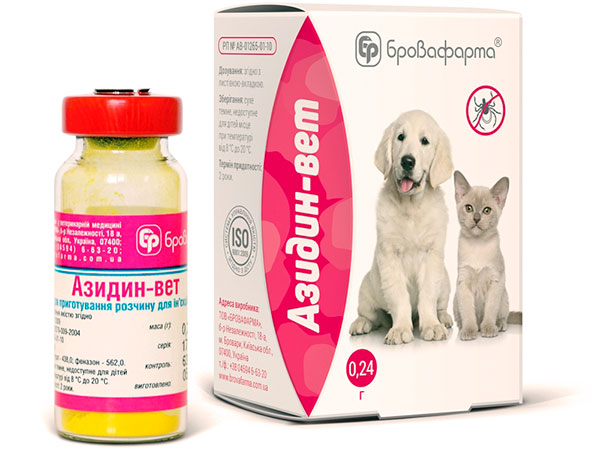
Azidin is an effective antiparasitic agent for the treatment of piroplasmosis in animals, but it has side effects.
By the way, it is partly because of the high likelihood of developing side effects that drugs for the treatment of piroplasmosis are prohibited from being used for preventive purposes, including after a tick has been found on a dog and if it is unequivocally known that it has been stuck for a long time, that is, if infected, it can pass the infection to the animal.
In addition to the main specific treatment for piroplasmosis, symptomatic therapy is almost always required to reduce the temperature, detoxify the dog's body, and normalize digestion. As a rule, such auxiliary treatment is organizationally more complicated than specific one, and therefore, in most cases, it is not carried out at home.
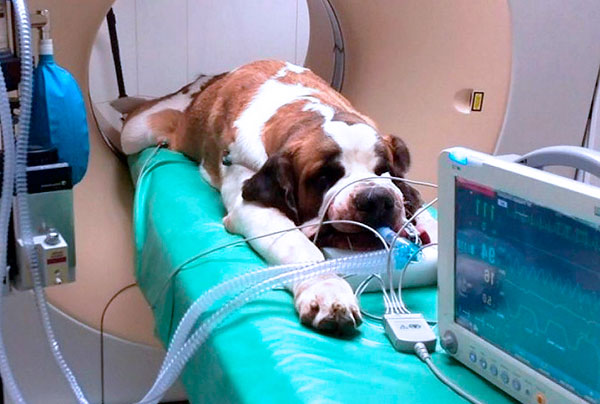
Piroplasmosis is treated, as a rule, in a veterinary clinic.
Be that as it may, the key to success in the treatment of piroplasmosis (and any other tick-borne infection in a dog) is the timely detection of the disease and the fastest possible start of taking effective drugs. And actions aimed at this should be carried out immediately after the tick was found on the dog.
The first steps to take when a tick is found on a dog
First of all, the tick must be removed from the dog. If the parasite has not yet bitten the pet, but simply crawls in the wool, it is enough just to remove it and throw it away.
If the tick has already stuck, it must be pulled out of the skin. It is important to do this correctly so as not to compress the body of the parasite (especially if it is already swollen) and not tear it away from the head, which will remain in the skin.
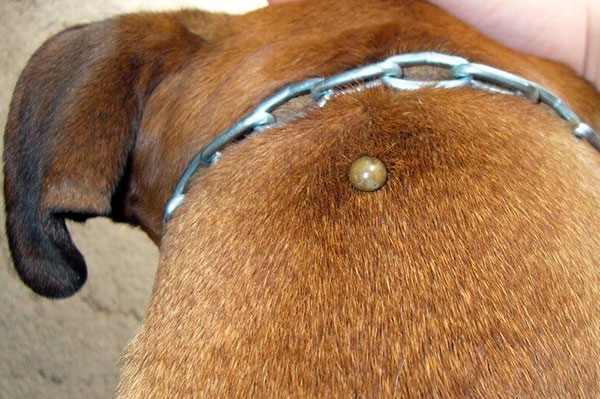
The engorged tick should be removed as carefully and carefully as possible so as not to compress it.
It's important to know
The longer the tick sucks blood, the more likely it is to inject an infectious dose of the pathogen into the wound. So, the sooner it can be removed, the lower the risk of infection. Therefore, the correct removal of a tick is the removal of it in the first seconds after it was found.
It is very important to ensure that the dog does not bite ticks from its paws (for example, between the balls of its fingers). The fact is that having bitten the parasite, the pet is likely to eat it, which will create a risk of infection with hepatozoonosis.
After removing the tick, you need to inspect the bite site. A small wound should remain here, sometimes blood or ichor is released from it, but no black or dark brown spines should remain in it - this is exactly what the remnants of the tick head look like, from which the body was torn off when pulled out. If they remain, they must also be removed (we will tell you how to do this below).
It is also normal if a bump appears at the site of the tick bite - this happens especially often when the tick is pulled out of the skin, damaging the layer of subcutaneous fatty tissue. The inflammatory exudate, which, in fact, sucked the tick, begins to spread here under the skin, which leads to the appearance of a bump. There is nothing wrong with it, no measures need to be taken to remove it, it will resolve itself in 2-3 days.
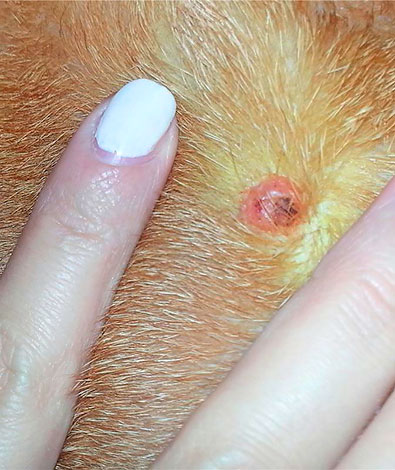
A bump after a tick bite should resolve within a few days.
On a note
The bump after removing the tick can itch, so it is useful to anoint it with some kind of anesthetic ointment so that the pet does not comb it.
If blood or ichor oozes from the wound for a long time, it can be treated with brilliant green, chlorhexidine or iodine. In most cases, this is not necessary.
After removal, the tick itself does not need to be preserved, and even more so, it is not necessary to take it to the clinic for analysis. The tick is not analyzed for piroplasmosis in clinics, and even if it were, the fact that there is an infection in its body does not unequivocally indicate that the dog will become infected when it bites.
The dog, by the way, also does not need to be taken to the clinic immediately after a tick bite. Parasites will not be found in her blood (even if an infection occurs), but they will take money for unnecessary procedures.
Be that as it may, it must be remembered that the incidence of piroplasmosis, even from obviously infected ticks, is low. And given that most of the parasites are not carriers of the causative agent of this disease, you can be sure that, most likely, after a tick bite, the dog will not get sick with anything. Therefore, after removing the parasite, it is enough to remember the date of the bite and simply observe the condition of the pet after that for 2-3 weeks.
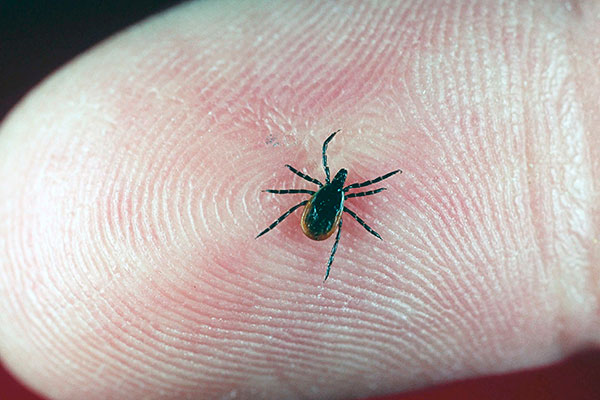
Be sure to remember the date of removal of the tick and monitor the behavior of the animal for several weeks.
It is worth remembering that infection with an infection is more likely if the tick found on the dog has been on it for several days and increases in size, as if it swells up, becoming like a smooth outgrowth on the skin of the animal. This only happens to adult females, who need a huge supply of blood to form eggs. They are on the dog's body for up to 5-7 days (sometimes it is even mistakenly believed that they live on a pet all the time) and during this time they can be found even in a dog of a long-haired breed - a Yorkie, Pekingese or Collie. Males drink blood much faster - in a few hours, sometimes up to a day.Nymphs can drink blood for 2-3 days, but still stay on the dog's body for less time than adult females. It is with such a long-term diet that the risk of transmitting pathogens to the dog is highest, and tick paralysis generally develops only on the second or third day of the tick attaching to the dog, when the partially fed parasite undergoes a restructuring of some internal organs and the paralyzing toxin itself begins to be produced.
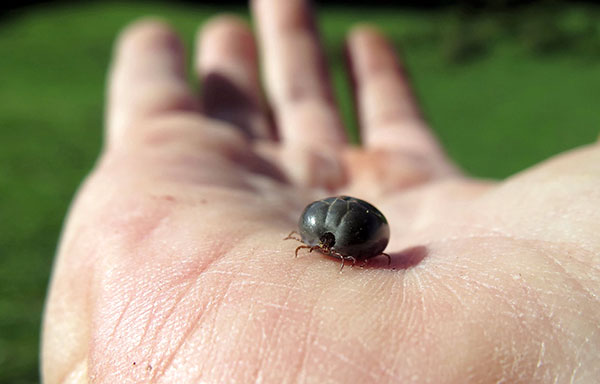
The longer the tick drinks blood, the higher the risk of transmitting pathogens to the victim.
This means that it is very important to inspect the dog after each walk, even if it was not possible to see a tick on it on the street. Most often, bloodsuckers are found in the ears, between the pads of the paws, in the groin and armpits of the dog. It is useful to comb long-haired dogs - Labradors, Spitz - after a walk, because when combing, parasites that have not yet attached themselves often remain in the comb.
Proper parasite removal
In the ideal case, the tick must be unscrewed with the help of special tongs - devices that allow you to grab the parasite under the body, and then scroll several times around its axis, which will loosen its grip in the wound and it will fall out.
Such tickers are numerous, have different shapes, but the most common models are in the form of hooks. They are tiny and are often worn on keychains as key chains or attached to a leash. People who often walk their dogs constantly wear such tickers for walks in the summer.
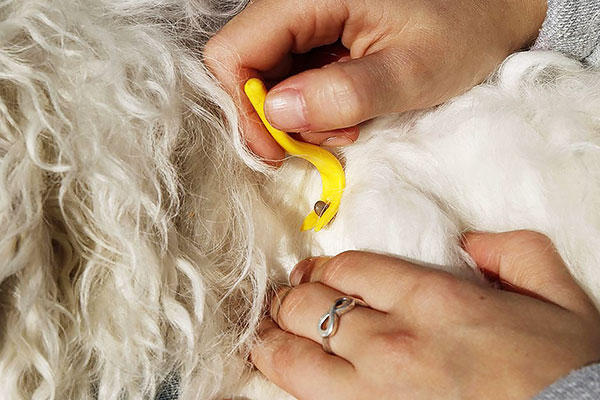
The kleshcheder is convenient when extracting a tick.
Klescheder can be made with your own hands from improvised materials.For example, ticks are recommended to be twisted with a thread, a loop from which is thrown and tightened under the body of the parasite, and then the ends of the thread are folded together and twisted into a tourniquet. Sometimes a ticker is recommended to be made from a simple stick with a slot at the end. However, by and large, all this is not necessary: precious minutes (at best) will be spent on the manufacture of such devices, during which the tick will inject saliva into the wound, possibly with infectious agents.
It is much more reasonable to simply unscrew and tear off the tick with your fingers, just to make it happen as quickly as possible. The rule here works: the speed of removing the parasite is more important than correctness and aesthetics. That's why:
- The tick can be caught under the body with the nails of two fingers, scrolled and tried to pull out;
- If the tick has not yet drunk blood, you can grab it with your fingers right behind the body and pull it out;
- Sometimes the parasite can be simply "picked off" with a fingernail.
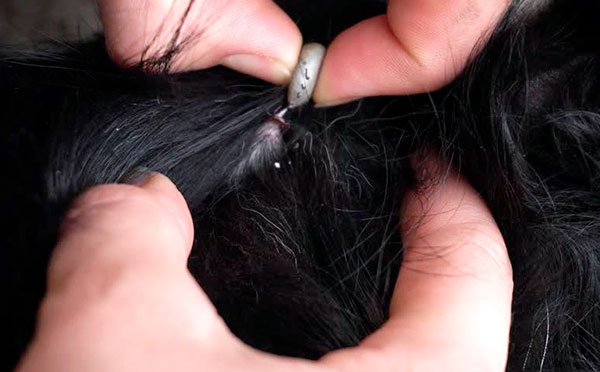
The tick can also be removed with your fingers, since the speed of removal is much more important than its method.
Even if, after removing the tick, the head of the parasite remains in the wound, it can then be removed with a needle or nail scissors in the same way as a splinter is removed.
There is no need to apply any additional measures after the removal of the parasite. The dog can be fed normal food, continue to walk with it according to the usual schedule. She does not need to prescribe certain drugs for prevention (most of the drugs that are effective against the same piroplasmosis are quite toxic and often cause side effects, which is why they are allowed to be used only if the pet's life is threatened from the disease itself).
If infection has occurred: the first symptoms of tick-borne infections
Most tick-borne infections have an incubation period of 2-3 weeks, but can be shorter (3-4 days) or longer (2-3 months). All this time, after a tick bite, the condition of the dog should be carefully monitored, and if the first symptoms of the disease are found, take it to the veterinarian and tell him when the bite occurred.
If the dog has been bitten several times lately, it is also necessary to tell the veterinarian so that he understands the likelihood of contracting a particular infection.
On a note
Of particular difficulty in such tracking of symptoms is tick-borne borreliosis - its incubation period normally lasts 14-18 days, but sometimes it can be delayed up to 6-8 months, and in some cases up to a year. During this period, it can be difficult, if not impossible, to associate symptoms with a particular tick bite. In this case, an accurate diagnosis of the disease is carried out according to the results of bacteriological studies.
In any case, if a dog becomes lethargic and does not eat immediately after a tick bite, then this condition is almost certainly not related specifically to this tick bite. Not a single infection develops so rapidly, and it takes at least several days for the reproduction of parasites in the body. The rapid deterioration of the condition of the dog immediately after the bite is possible with allergies, but it is very rare. Be that as it may - whether the weakening of the animal is associated with a bite or not - the dog needs to be shown to the veterinarian.

If the condition of the dog after a tick bite began to deteriorate sharply, then it must be urgently taken to a specialist.
The first signs of major tick-borne infections in dogs are similar:
- The dog becomes less mobile, lethargic, lies a lot;
- Body temperature rises to 41-42;
- The mucous membranes of the eyes and mouth become pale, with piroplasmosis - with an icteric tinge;
- The color of urine changes, it becomes dark, sometimes coffee-colored;
- The dog refuses to eat, she may begin to vomit.
For piroplasmosis and - especially - for tick paralysis, weakness of the hind legs of the dog is a significant symptom. The animal can unnaturally squat on them when moving, sometimes even dragging them along.
In the event of such symptoms, the pet should in any case be shown to the veterinarian. If it is known that during the last 1-2 weeks the dog was bitten by a tick, this must be reported to the doctor at the visit - this is how he will diagnose, taking into account the high probability of piroplasmosis or ehrlichiosis.
It's important to know
The speed of such a visit to the veterinarian determines whether the dog will survive after the onset of symptoms of the disease. According to statistics, with piroplasmosis, the largest number of dog deaths occurs 4-5 days after the onset of the first symptoms. Moreover, in many cases, the owners do not pay attention to the first signs of the disease, considering them an insignificant ailment, and miss the first 1-2 days, during which competent measures will be most effective. It is this omission that often leads to the death of a pet.
It makes no sense to provide intuitive first aid to the dog at the first signs of illness. Sometimes, if the pet's condition worsens very quickly, the animal passes out, begins to choke, you need to phone the veterinarian and follow his instructions - you may need to inject an antihistamine or adrenaline. But in most cases, the best first aid for an animal is getting it to the clinic.
Fundamentals of the treatment of piroplasmosis, tick paralysis, ehrlichiosis and other diseases
Most tick-borne infections in dogs require both etiotropic and general symptomatic therapy.
In the treatment of piroplasmosis, antiprotozoal drugs are used:
- Berenyl;
- Veriben;
- Batrizin;
- Azidine;
- Diprocarb;
- Imidosan.

Drugs used to treat piroplasmosis.
Additionally, depending on the condition of the animal and its reaction to drugs, cardiac, antihistamine, hormonal, hepatoprotective, antipyretic drugs are used. In some cases, dogs are given droppers and drugs are administered by infusion.
If the condition of the animal allows, the treatment is carried out on an outpatient basis: the veterinarian comes to give injections, and the owners provide additional therapy. The doctor will also indicate how to feed the dog in a particular case.
Diseases caused by bacterial infections - ehrlichiosis, spotted fever, borreliosis - are treated with antibiotics. Moreover, with the timely start of treatment, a favorable outcome is more likely and the recovery of the pet's health occurs faster than with piroplasmosis. However, adjuvant therapy for these diseases is also needed.
Recovery from piroplasmosis usually occurs within 3 weeks to 3 months. If a dog falls ill with borreliosis, competent treatment puts it on its feet in 2-4 weeks, with ehrlichiosis - in 2-3 weeks.
What to do so that bites do not recur in the future
Effective prevention of tick bites in dogs is the use of drugs that repel parasites that have already caught on the pet's fur.It is almost impossible to prevent a tick from catching on hair - the bloodsucker does it reflexively: when it smells an approaching animal, it immediately spreads its front paws to the sides, and as soon as the dog touches the blade of grass on which it sits, it immediately grabs onto its hair.

Photo of a tick ready to attack.
To some extent, anti-mite overalls can prevent such contact with wool, but they have many disadvantages. Firstly, you can’t dress a large dog in such a jumpsuit, and secondly, it does not cover the head and paws, for which the bugs cling especially often. Thirdly, in the summer, during the tick season, it can be hot for a pet in overalls. Finally, if a dog has picked up a tick, for example, on its paw, it can get under the overalls (although this is unlikely) and bite it under the protection of the fabric, remaining completely invisible.
As a result, in the summer you need to be prepared for the fact that ticks will cling to the dog. To reduce the likelihood of bites after this, you need to:
- Apply special drops to the withers, the active substance of which will spread through the subcutaneous tissue throughout the body of the animal and will scare away the tick that is on the skin and which will bite through it for bloodsucking. As a result, it will neither suck blood nor transmit pathogens (although there is still a minimal risk);
- Put on a special anti-tick collar on the dog - it works the same way as drops;
- Treat the dog's coat with a tick spray;
- After the walk, examine the body of the pet, paying special attention to the ears, groin and armpits.
It is believed that, to a certain extent, various strong-smelling home-made preparations repel ticks - mixtures of essential oils, vodka with vanillin, clove oil emulsion. However, such funds cannot be considered absolutely reliable.
It is useful to cut long-haired dogs for the summer, because on short - up to 3-4 mm - hair, ticks are clearly visible and can be removed before they stick.
Finally, in fact, you should walk your pet in those places where the risk of picking up a tick will be minimal. It is advisable to avoid places with tall grass, wildlife trails (ticks are attracted to them by the constant smell of animals), livestock grazing areas. Small dogs should be prohibited from climbing into the burrows of foxes and badgers (unless they are specialized burrowing dogs whose main task is to hunt these animals in burrows).
Practice shows that the implementation of these measures allows you to minimize the risk for the dog to catch a tick and get sick with a dangerous disease.
How to protect your pet from ticks and the consequences of their bites? The specialist tells
Useful video about piroplasmosis in dogs: causes of the disease, symptoms, treatment


